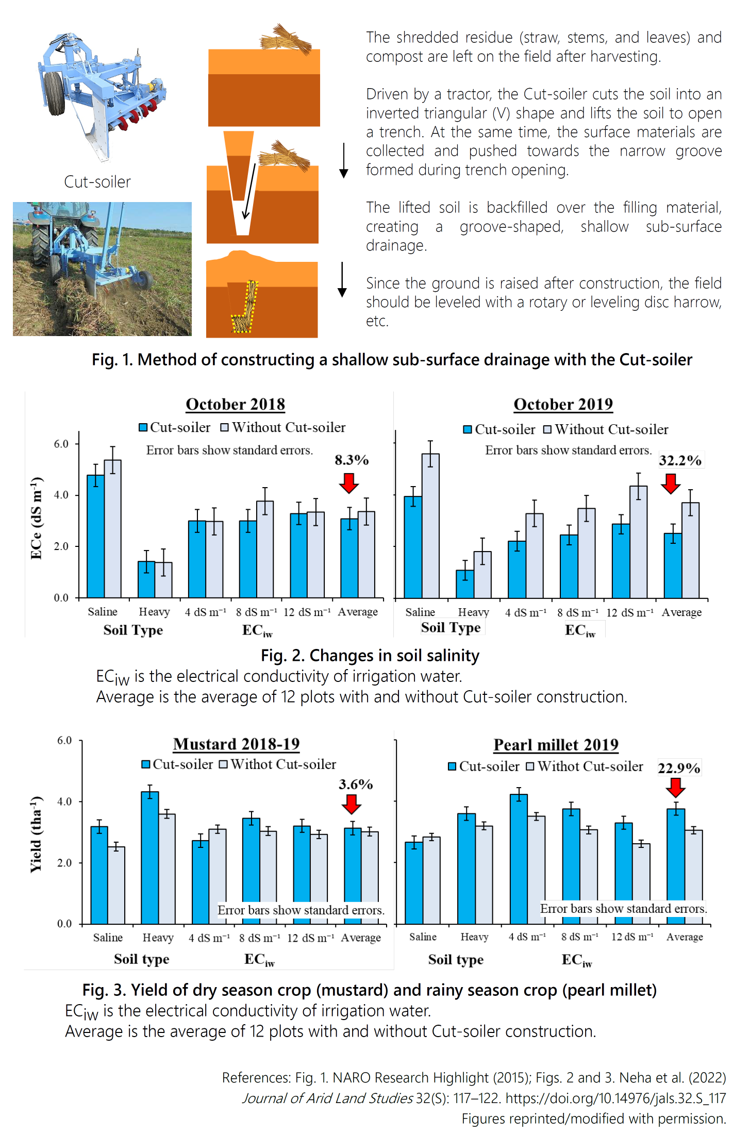Shallow sub-surface drainage constructed with “Cut-soiler” mitigates soil salinity
Description
In the Indo-Gangetic Plain, groundwater irrigation dramatically improved agricultural production. However, salinization has become a serious issue due to the high salinity of irrigation water and poor drainage. Construction of open and/or sub-surface drainage is effective at mitigating salinization, but it is difficult for farmers to implement due to the high cost. Therefore, towards developing sustainable drainage measures that farmers can practice, we conducted research and created a low-cost method of constructing shallow sub-surface drainage using a Japan-built tractor attachment called the “Cut-soiler.”
Conventionally, when constructing a material-filled sub-surface drainage, it is necessary to prepare the hydrophobic material to be buried in the soil and load it into the construction machine. This method does not require these works, and harvested residues such as rice and wheat straw scattered on the field can be buried underground simply by running a tractor equipped with the Cut-soiler. The method involves cutting the soil into an inverted trapezoid, then lifting it up to make space from the ground surface to a depth of 40 to 60 cm. The crop residue, spread to a width of 120 cm, is then pushed into this space to make a shallow sub-surface drainage (Fig. 1). Shallow sub-surface drainage (60-cm depth) constructed with the Cut-soiler reduced soil salinity (ECe: electrical conductivity of the solution extracted from the saturated soil) by 8% (no significant difference) and 32% (P=0.047) at 4 and 16 months after construction, respectively (Fig. 2). Meanwhile, the yield improved by 4% (no significant difference) and 23% (P=0.048) in the dry season crop (November to March: mustard) and in the rainy season crop (June to September: pearl millet), respectively (Fig. 3).
The construction method has been compiled into a manual, titled “Cut-soiler constructed Preferential Shallow sub-surface drainage for mitigating salinization User’s Guide,” and is now available on the JIRCAS website for its further extension. It is expected to be used for salinization countermeasures by the Central Saline Soil Research Institute (CSSRI) in India. Regarding the method and equipment, the following should be noted. The drainage condition should be checked in advance as this method depends on the drainage condition around the field. Then, a suitable construction method should be chosen. The Cut-soiler does not have wheels, so it must be loaded onto a truck when transporting long distances. The estimated useful life of the Cut-soiler is around 7 years covering 30–50 ha of construction area per year. If there is no problem with the frame, it can be used continuously by simply replacing consumables.
Figure, table
- Research project
- Program name
- Term of research
-
FY2018–2022
- Responsible researcher
-
Onishi Junya ( Rural Development Division )
Kouda Kazuhisa ( Rural Development Division )
MIERUKA ID: 001756Matsui Kayo ( Rural Development Division )
KAKEN Researcher No.: 10814189Anzai Toshihiko ( Tropical Agriculture Research Front )
Okamoto Ken ( Tropical Agriculture Research Front )
Lee Guenwoo ( Social Sciences Division )
ORCID ID0000-0001-5623-6205KAKEN Researcher No.: 80836643Watanabe Takeshi ( Research Planning and Management Office )
Omori Keisuke ( Information and Public Relations Office )
Kitagawa Iwao ( Institute for Rural Engineering, NARO )
Chaudhari Suresh Kumar ( Indian Council of Agricultural Research )
Yadav Rajender Kumar ( Central Soil Salinity Research Institute )
ORCID ID0000-0003-1436-2072Yadav Gajender ( Central Soil Salinity Research Institute )
Neha ( Central Soil Salinity Research Institute )
Rai Arvind Kumar ( Central Soil Salinity Research Institute )
Kumar Satyendra ( Central Soil Salinity Research Institute )
Narjary Bhaskar ( Central Soil Salinity Research Institute )
ORCID ID0000-0002-3148-2204Sharma Parbodh Chander ( Central Soil Salinity Research Institute )
ORCID ID0000-0002-5783-7480 - ほか
- Publication, etc.
-
安西ら. (2021) 水土の知 90 (2): 31–35.
Onishi et al. (2021) Journal of Soil Salinity and Water Quality 13(2), 157–163.
https://doi.org/10.14976/jals.32.S_83Onishi et al. (2022) Journal of Arid Land Studies 32(S), 83–87.
https://doi.org/10.14976/jals.32.S_107Anzai et al. (2022) Journal of Arid Land Studies 32(S), 107–111.
https://doi.org/10.14976/jals.32.S_221Okamoto et al. (2022) Journal of Arid Land Studies 32(S),221–226.
https://doi.org/10.14976/jals.32.S_117Neha et al. (2022) Journal of Arid Land Studies 32(S), 117–122.
- Japanese PDF
-
2022_A11_ja.pdf990.96 KB
- English PDF
-
2022_A11_en.pdf685.41 KB
* Affiliation at the time of implementation of the study.

